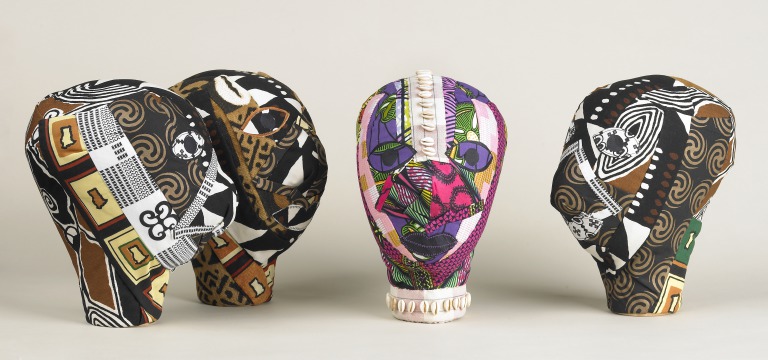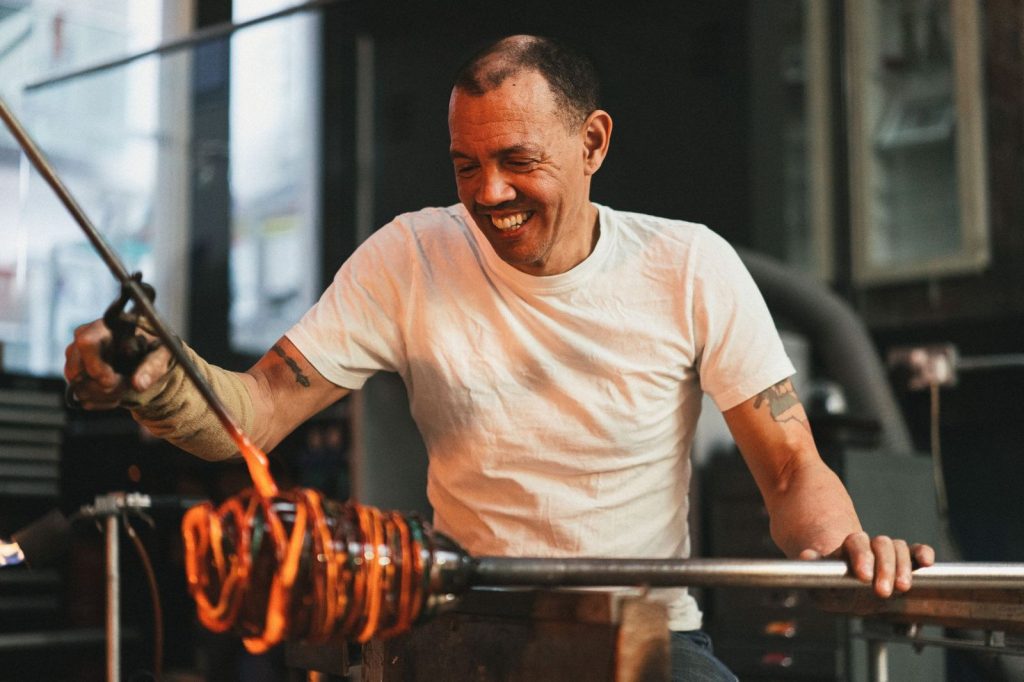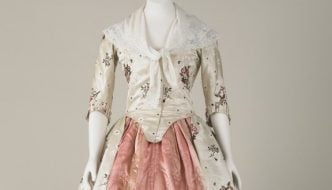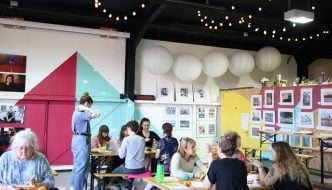
For Black History Month, National Museums Liverpool is hosting several exhibitions across its various venues – Lorraine Bacchus reviews a few of those exhibiting at Walker Art Gallery, the World Museum, Museum of Liverpool and International Slavery Museum.
“Each stitch represents a deliberate and thoughtful effort to mend the wounds of history” – Karen McLean.
McLean’s heartfelt words about her installation at the Walker Art Gallery can equally apply to the other efforts being made by National Museums Liverpool (NML) across all their venues to commemorate this year’s Black History Month (BHM). Relatively unknown events from Liverpool’s historical links to slavery are the catalyst for some of the wide range of specially commissioned artworks, while elsewhere the contribution to the city by “Black Scousers” is celebrated. They all demonstrate the power of art to provide a vocabulary for debate and learning.
For her installation, Stitching Souls, McLean, a British Trinidadian artist, has created a memorial to the victims of the 1781 Zong Massacre. The Zong, a slaving ship financed by a group of Liverpool businessmen, was the focus of a notorious court case in which it was revealed that 133 enslaved African people had been thrown overboard to reduce demand on supplies. Enslaved people were routinely insured at sea as ‘cargo’ and treated as non-human objects. The lives and identities of those who drowned remain unknown. Once back in port the Zong’s crew sought compensation for the loss of their ‘cargo’.
What visitors see when they enter the Gallery’s first-floor atrium is one of those artworks that, at first, delights the eye with its vibrant display, maybe even provokes a smile. And then, an inner silence descends as the awful truth of what it represents seeps through. What we see is a series of heads made from colourful, authentic African fabrics, one for each man, woman and child who was murdered in the Zong massacre. They are mounted on poles, which I found troubling, given how severed heads have been used throughout history as propaganda in warfare. But after a while of standing with them, the installation takes on the dignified and poignant atmosphere I’m sure was the intention. To quote from one of McLean’s inspirations: “The past is laid to rest when it is told” – Fred D’Aguiar, author of ‘Feeding the Ghosts’, a fictional account of the Zong tragedy.
McLean made the heads using traditional quilting techniques in collaboration with a community of embroiderers in her home city of Birmingham. Each one is unique, with the strips of fabric, cowrie shells and other adornments giving each of them an identity. You can see some of this process in the short video at the start of the installation. It was important to her that authentic African fabrics were used: “The practice of quilting is deeply rooted in Southern and African American traditions, used as a form of storytelling, creativity and community-building. My work honours this legacy by bringing the past and present together to encourage a larger conversation about memory, history and justice”. These stitched souls are the epitome of a labour of love.
Stitching Souls is at the Walker Art Gallery until 2 Mar 2025.

In one of the nearby rooms, is a new commission from the glass artist, Chris Day. I’ve had an image of his work on my studio wall for ages, torn from a magazine years ago, so I was already a fan of his radical approach to glass blowing. And this presentation does not disappoint. His day job (sorry about the pun) was as a plumber and he still uses some of the tools of his trade – wire, copper piping – to manipulate the glass into extraordinary, amorphic shapes contained in cages.
For this installation, Day has added another dimension to their constricted space by further enclosing the sculptures in wooden crates. They are almost hidden, which is the point Day wanted to make. He made the series of works in response to the Gallery’s painting, The Card Party, by Gawen Hamilton (1698-1737). It’s a portrait of a rather banal drawing room scene but if you look really closely you can just make out the small figure in the bottom left-hand corner of an enslaved Black boy. The title of Day’s display, ‘Now you see me’, explains his purpose – that it is all about making this child visible, to make him seen, as a symbol of all those forgotten, invisible, enslaved people: “My passion”, he says, “lies in making work that sparks reflection on the transatlantic slave trade.”
I’d like to give a shout out for the Contemporary Art Society (CAS), a charity that champions the collecting of outstanding contemporary art and craft for public collections in the UK. It is through CAS that Day’s commission has been donated to the Walker. Christine Takengy, Senior Curator at the Society, describes his work as important in helping the Gallery de-colonialise its collection: “Day’s work is both poignant and timely … bringing to light the concealed histories of the many enslaved people that passed through [Liverpool’s] port”.
Now you see me: Chris Day Walker Art Gallery, until 24 November 2024. Free.

Coming soon to the Walker as part of BHM is Conversations, an exhibition that brings together work by around 40 Black British women and non-binary artists. It is part of a wider research and collecting project through which the Walker aims to acquire new artworks by artists who are currently under-represented within its collection.
It also aims to expand the discourse around Black British art, which the Project’s Curator, Sumuyya Khader, feels tends to focus on work made by a handful of artists, predominantly in the 1980’s and 90’s: “While the exhibition acknowledges the impact and importance of their work, we want to focus on the vital conversations that contemporary artists are having with each other and with audiences right now. Through joyful, timely and thought-provoking pieces, they are responding to our current cultural climate – demonstrating how art can provide an avenue for interaction, exploration and learning.”
A wide range of media will be represented, from traditional fine art practices including painting and sculpture, to contemporary forms such as sound and installation, most of which date from the last ten years. The majority of the artworks have been borrowed directly from the artists themselves, with others from public collections and a small number from NML’s own collection.
A steering group, representing a cross-section of artists, curators and academics from across the UK, had the difficult task of selecting the artists for the exhibition. The full list of the exhibiting artists can be found here. ‘Conversations’ is supported by Art Fund and the Paul Mellon Centre for Studies in British Art.
‘Conversations’ – Walker Art Gallery, 19 October – 9 March 2025. Free entry.

The usual pristine whiteness of the Gallery’s sculpture hall has been dramatically interrupted by the presence of a large sculpture by Zak Ové, a British and Caribbean artist. His work, ‘Lost Soul IV’, is described as symbolising the continued pursuit of equality through acts of remembrance and resistance. It also reflects his belief in the power of self-emancipation through the culture of Carnival and Masquerade.
The sculpture is one of a series of striking interventions throughout the Gallery as part of its BHM programme, Carving Out Truths. Another, is a reading of Kinky Hair Blues by Una Marson, a deceptively quiet poem that was challenging the Western concept of ideal beauty way back in the 1930’s. Have a listen.
Sadly, its poignancy is equally as relevant today. Marson was an extraordinary woman who broke through all kinds of barriers, despite battling with mental illness. In addition to her poetry, she was also a playwright, journalist, performer and a fervent activist, committed to advancing Black people’s rights.
The choice of these and many other interventions was made by a group of young people from Liverpool’s Black and Global Ethnic Majority communities, working with the Walker’s team to research and reinterpret its collection. In particular they focused on individuals and stories that have previously been excluded. Some of those involved talk here about the process and what it meant to them. Their personal reflections and perspectives are also displayed beside various sculptures in the Gallery. They feature flowers and plants associated with African culture and heritage inspired by the Domestic World-Making Enslaved Project.
‘Carving Out Truths’ has been supported by Art Fund through a Headley Fellowship and Art Friends Merseyside.
—
Next door at the World Museum, the focus is on its extensive collection of Nigerian art and architecture. Rethinking Relationships Discovery Day is a free one-day event on Saturday 19th October from 12.00-16.00. Its aim is to give people an opportunity to learn more about a new project, which hopes to involve people based both in Merseyside and Nigeria. Any group or individuals interested in shaping the project can do so. This might include feedback sessions, historical research, creative responses, contributions to new learning resources, and/or the chance to be involved in a new community-curated display. If you cannot attend and think you want to be involved in the project, email [email protected] to learn more.
—
Down at the docks at the Museum of Liverpool, there’s a celebration of Black Scousers and the many achievements and contributions they have brought to the city. A series of free tours of the museums collections aims to draw out some of their stories, as Chris Kerfoot, Participation Programme Manager describes: “The Museum is bursting with such stories of individuals who have achieved great things and made our city proud. We celebrate the contribution of Black Scousers all year round, but it is a joy to throw a special spotlight on them during Black History Month”. The tours of Inspirational Black Scousers start at 11.00 and are available on 17 & 23 October.
—
Meanwhile, at the International Slavery Museum, a series of new interventions of contemporary art reframe how certain historical objects in the collection are perceived and understood.
In addition, Emergence as Empowerment is an evening event co-hosted by NML and the University of Liverpool. The focus will be a screening of Delado: Rising from the Ashes – a documentary, which delves into the tension of Liverpool 8 following the 1981 Toxteth Uprisings, when local underdogs emerged as a performance collective primarily under the wing of Ghanaian performance teachers. Preceding the documentary will be a live conversation with Elliss Eyo-Thompson (Project Facilitator at International Slavery Museum) and storyteller Kelechi Okafor.
Emergence as Empowerment is a ticketed event. 25 October, 18.00-20.30
***
Opportunities for Black History Month celebration and learning also extend online, with National Museums Liverpool’s collections, articles, videos and podcasts available all year via its digital hub: www.liverpoolmuseums.org.uk/black-history
Filed under: Art & Photography
Tagged with: black art, black history, Black History Month, contemporary art, Liverpool art, liverpool museums, National Museums Liverpool, slavery, Walker Art Gallery



Comments